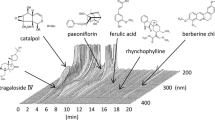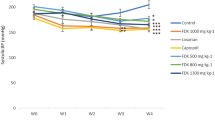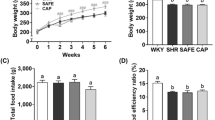Abstract
The antihypertensive activity of few-flower wild rice was studied in spontaneously hypertensive rats (SHRs) with evaluation of blood pressure lowering effects and transcriptional levels of the sarcoplasmic reticulum Ca2+-ATPase (SERCA2a) gene that is regulated by Angiotensin II (Ang II). SHRs were randomly divided into 5 groups with 6 rats each. The systolic blood pressure (SBP) reached the lowest point 3 h after administration of a single dose of paste made from few-flower wild rice stem powder. The SBP of SHR in the relatively high amount of RSP (HRSP) administrated group was reduced by approximately 30 mmHg, compared to the negative control group, and was not significantly different from the positive control IPP control group at a dose of 1.5 mg/kg body weight (p>0.05). RSP administrated SHRs showed a significantly higher SERCA2a transcription level than negative control SHRs (p<0.05). RSP administration had no negative effects on glycometabolism of SHR.
Similar content being viewed by others
References
National High Blood Pressure Education Program Coordinating Committee. The sixth report of the Joint National Committee on prevention, detection, evaluation, and treatment of high blood pressure. Arch. Intern. Med. 157: 2413–2446 (1997)
Ezzati M, Vander Hoorn S, Lawes CMM, Leach R, James WPT, Lopez AD, Rodgers A, Murray CJL. Rethinking the “diseases of affluence” paradigm: Global patterns of nutritional risks in relation to economic development. PLoS Med. 2: e133 (2005)
Department of Disease Control, Ministry of Health, China, National Center for Cardiovascular Diseases China, China Hypertension League (2010). Chinese guidelines for the management of hypertension (2010). People’s Medical Publishing House, Beijing, China (2012)
Guyton AC, Coleman TG, Cowley AW, Scheel KW, Manning RD, Norman RA. Arterial pressure regulation: Overriding dominance of the kidneys in long-term regulation and in hypertension. Am. J. Med. 52: 584–594 (1972)
Bakris GL, Mensah GA. Pathogenesis and clinical physiology of hypertension. Curr. Prob. Cardiology 28: 137–155 (2003)
Asano K, Zisman LS, Bristow MR. Angiotensin II receptors in the normal and failing heart. Heart Fail. Rev. 3: 199–208 (1999)
Magnier-Gaubil C, Herbert JM, Quarck R, Papp B, Corvazier E, Wuytack F, Lévy-Tolédano S, Enouf J. Smooth muscle cell cycle and proliferation: Relationship between calcium influx and sarcoendoplasmic reticulum Ca2+ATPase regulation. J. Biol. Chem. 271: 27788–27794 (1996)
Cui ZQ, Chen X, Chen LY, Liu LS. Effect of angiotensin II on the transcription and regulation of sarcoplasmic reticulum Ca 2+, Mg 2+-ATPase gene in rat heart. Chin. J. Biochem. Mol. Biol. 15: 284–288 (1999)
Tong X, Evangelista A, Cohen RA. Targeting the redox regulation of SERCA in vascular physiology and disease. Curr. Opin. Pharmacol. 10: 133–138 (2010)
Park PJ, Je JY, Kim SK. Free radical scavenging activity of chitooligosaccharides by electron spin resonance spectrometry. J. Agr. Food Chem. 51: 4624–4627 (2003)
Kang DG, Kim YC, Sohn EJ, Lee YM, Lee AS, Yin MH, Lee HS. Hypotensive effect of butein via the inhibition of angiotensin converting enzyme. Biol. Pharm. Bull. 26: 1345–1347 (2003)
Nyman U, Joshi P, Madsen LB, Pedersen TB, Pinstrup M, Rajasekharan S, George V, Pushpangadan P. Ethnomedical information and in vitro screening for angiotensin-converting enzyme inhibition of plants utilized as traditional medicines in Gujarat, Rajasthan, and Kerala (India). J. Ethnopharmacol. 60: 247–263 (1998)
Balasuriya BWN, Rupasinghe HPV. Plant flavonoids as angiotensin converting enzyme inhibitors in regulation of hypertension. Funct. Food Health Dis. 5: 172–188 (2011)
Lee JE, Bae IY, Lee HG, Yang CB. Tyr-Pro-Lys, an angiotensin I-converting enzyme inhibitory peptide derived from broccoli (Brassica oleracea Italica). Food Chem. 99: 143–148 (2006)
Qian BJ, Luo YL, Deng Y, Cao LK, Yang HS, Shen YP, Ping J. Chemical composition, angiotensin-converting enzyme-inhibitory activity and antioxidant activities of few-flower wild rice (Zizania latifolia Turcz.). J. Sci. Food Agr. 92: 159–164 (2012)
Qian BJ, Xing MZ, Cui L, Deng Y, Xu YQ, Huang MN, Zhang SH. Antioxidant, antihypertensive, and immunomodulatory activities of peptide fractions from fermented skim milk with Lactobacillus delbrueckii ssp. bulgaricus LB340. J. Dairy Res. 78: 72–79 (2011)
Nakamura Y, Yamamoto N, Sakai K, Takano T. Antihypertensive effect of sour milk and peptides isolated from it that are inhibitors to angiotensin I-converting enzyme. J. Dairy Sci. 78: 1253–1257 (1995)
Ding FY, Qian BJ, Zhao X, Shen SQ, Deng Y, Wang DF, Zhang F, Sui ZQ, Jing P. VPPIPP and IPPVPP: Two hexapeptides innovated to exert antihypertensive activity. PLoS One 8: e62384 (2013)
Lee CE, Hur HJ, Hwang JT, Sung MJ, Yang HJ, Kim HJ, Park JH, Kwon DY, Kim MS. Long-term consumption of platycodi radix ameliorates obesity and insulin resistance via the activation of AMPK pathways. Evid-Based Compl. Alt. 2012: 1–11 (2012)
Zhang H, Liang W, Yang X, Luo X, Jiang N, Ma H, Zhang D. Carbon starved anther encodes a MYB domain protein that regulates sugar partitioning required for rice pollen development. Plant Cell 22: 672–689 (2010)
Collaboration PS. Age-specific relevance of usual blood pressure to vascular mortality: A meta-analysis of individual data for one million adults in 61 prospective studies. Lancet 360: 1903–1913 (2002)
Schillaci G, Pirro M, Mannarino E. Assessing cardiovascular risk: Should we discard diastolic blood pressure? Circulation 119: 210–212 (2009)
Nakamura Y, Yamamoto N, Sakai K, Takano T. Antihypertensive effect of sour milk and peptides isolated from it that are inhibitors to angiotensin I-converting enzyme. J. Dairy Sci. 78: 1253–1257 (1995)
Hertog MG, Feskens EJ, Hollman PC, Katan MB, Kromhout D. Dietary antioxidant flavonoids and risk of coronary heart disease: The Zutphen Elderly study. Lancet 342: 1007–1011 (1993)
Hertog MG, Kromhout D, Aravanis C, Blackburn H, Buzina R, Fidanza F, Giampaoli S, Jansen A, Menotti A, Nedeljkovic S, Pekkarinen M, Simic BS, Toshima H, Feskens EJ, Hollman PC, Katan MB. Flavonoid intake and long-term risk of coronary heart disease and cancer in the seven countries study. Arch. Intern. Med. 155: 381–386 (1995)
Hertog MG, Feskens EJ, Kromhout D. Antioxidant flavonols and coronary heart disease risk. Lancet 349: 699 (1997)
Knekt P, Jarvinen R, Reunanen A, Maatela J. Flavonoid intake and coronary mortality in Finland: A cohort study. Brit. Med. J. 312: 478–481 (1996)
Rimm EB, Katan MB, Ascherio A, Stampfer MJ, Willett WC. Relation between intake of flavonoids and risk for coronary heart disease in male health professionals. Ann. Intern. Med. 125: 384–389 (1996)
Yochum L, Kushi LH, Meyer K, Folsom AR. Dietary flavonoid intake and risk of cardiovascular disease in postmenopausal women. Am. J. Epidemiol. 149: 943–949 (1999)
Miller NJ. Flavonoids and phenylpropanoids as contributors to the antioxidant activity of fruit juices. pp. 387–403. In: Flavonoids in Health and Disease. Rice-Evans A, Packer L (eds). Marcel Dekker Inc., New York, NY, USA (1998)
Gryglewski RJ, Korbut R, Robak J, Swies J. On the mechanism of antithrombotic action of flavonoids. Biochem. Pharmacol. 36: 317–322 (1987)
Duarte J, Pérez Vizcaíno F, Utrilla P, Jiménez J, Tamargo J, Zarzuelo A. Vasodilatory effects of flavonoids in rat aortic smooth muscle. Structure-activity relationships. Gen. Pharmacol. 24: 857–864 (1993)
Duarte J, Pérez-Vizcaíno F, Zarzuelo A, Jiménez J, Tamargo J. Vasodilator effects of quercetin in isolated rat vascular smooth muscle. Eur. J. Pharmacol. 239: 1–7 (1993)
Duarte J, Pérez-Palencia R, Vargas F, Ocete MA, Pérez-Vizcaino F, Zarzuelo A, Tamargo J. Antihypertensive effects of the flavonoid quercetin in spontaneously hypertensive rats. Brit. J. Pharmacol. 133: 117–124 (2001)
Hermansen K. Diet, blood pressure, and hypertension. Brit. J. Nutr. 83: S113–S119 (2000)
Boelsma E, Kloek J. Lactotripeptides and antihypertensive effects: A critical review. Brit. J. Nutr. 101: 776–786 (2009)
Author information
Authors and Affiliations
Corresponding author
Rights and permissions
About this article
Cite this article
Deng, Y., Luo, Y., Qian, B. et al. Antihypertensive effect of few-flower wild rice (Zizania latifolia Turcz.) in spontaneously hypertensive rats. Food Sci Biotechnol 23, 439–444 (2014). https://doi.org/10.1007/s10068-014-0060-1
Received:
Revised:
Accepted:
Published:
Issue Date:
DOI: https://doi.org/10.1007/s10068-014-0060-1




